Asia Pacific Poultry Feed Market Size
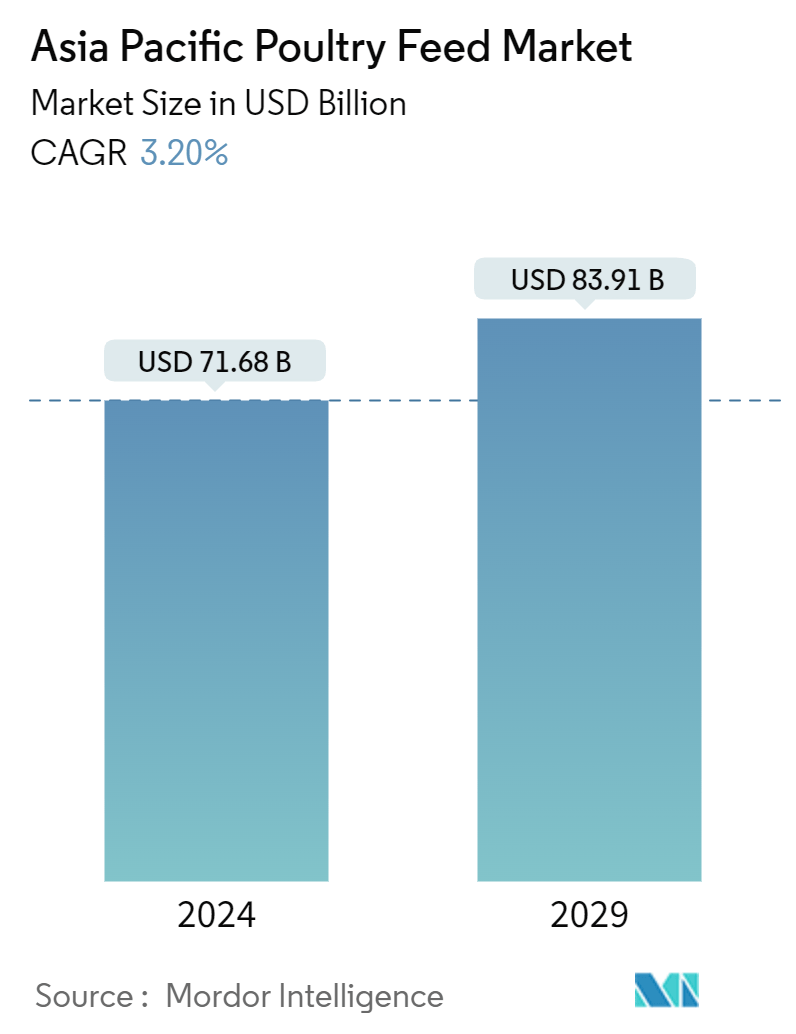
| Study Period | 2019 - 2029 |
| Base Year For Estimation | 2023 |
| Forecast Data Period | 2024 - 2029 |
| Market Size (2024) | USD 71.68 Billion |
| Market Size (2029) | USD 83.91 Billion |
| CAGR (2024 - 2029) | 3.20 % |
Major Players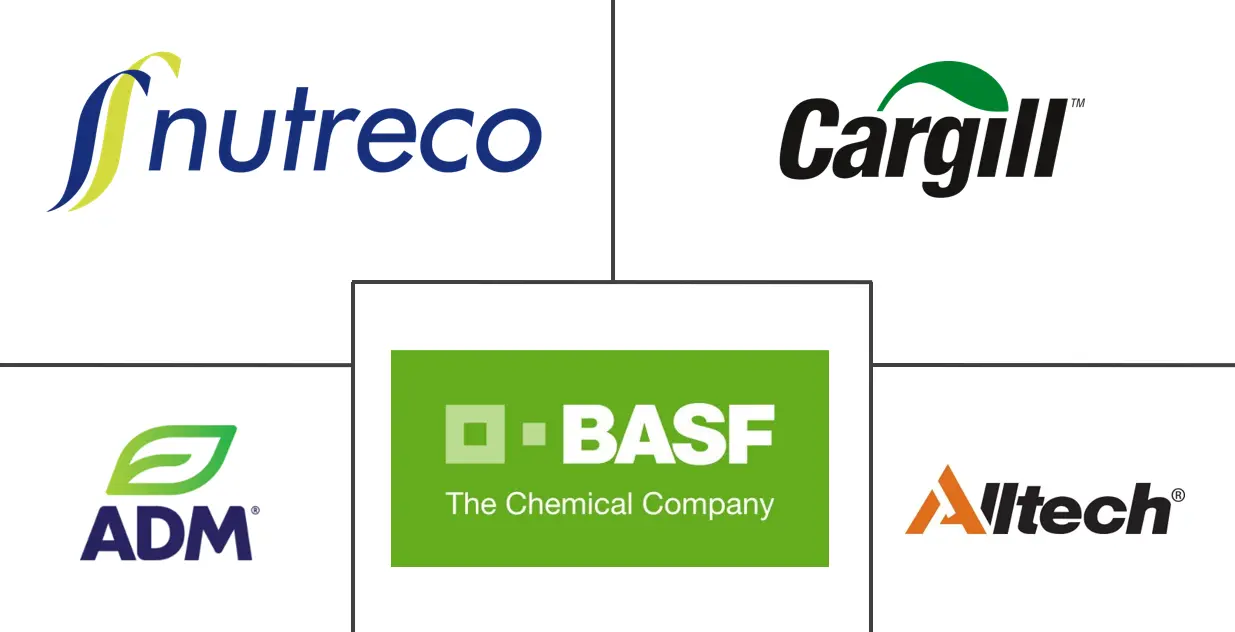
*Disclaimer: Major Players sorted in no particular order |
Asia Pacific Poultry Feed Market Analysis
The Asia Pacific Poultry Feed Market size is estimated at USD 71.68 billion in 2024, and is expected to reach USD 83.91 billion by 2029, growing at a CAGR of 3.20% during the forecast period (2024-2029).
Asia-Pacific is the leading poultry feed-producing and consuming region in the world, thereby inflicting a direct impact on the feed market. The increased scale of industrial livestock production in the region has significantly contributed to increased feed production capacities in major economies across the region. As per FAO, the total production reached 1,118,543.7 thousand metric tons for poultry in 2022, as compared to 1,108,749.2 thousand metric tons in 2021 in Asia-Pacific.
The increasing demand for poultry meat products is the major factor driving the market. The rising industrial livestock production and demand for organic feed are two other factors augmenting the market's growth. Poultry is considered one of the most economical sources of protein, due to which poultry products such as eggs and meat are consistently witnessing growth in demand. Furthermore, the rising incomes of the consumers and increasing urbanization in Asia-Pacific are leading to increased demand for poultry products, which, in turn, is leading to the growth of the market studied.
Corn is a major component used for manufacturing other poultry feeds prepared for birds such as ducks, turkeys, and quail. In the upcoming years, the production of compound feed for other poultry birds is expected to flourish due to the policies being formulated for the upliftment of corn production in the Philippines and other Asia-Pacific regions. For instance, in August 2022, the governor of a province in the southeastern corner of the island of Mindanao, Philippines, initiated the consideration of proposals that aimed to expand corn production for use in poultry compound feed. Moreover, there has been an increase in investments in the region's poultry feed-production industry, which would boost the development of the poultry compound feed-production market in the countries. For example, in January 2024, San Miguel, one of the nation’s top commercial feed producers, initiated its plans of investing PHP 21 billion (USD 384 million) in the poultry feed and poultry industry in the country, along with opening 12 new poultry feed facilities.
Furthermore, the poultry industry is also benefiting from government incentives to support recovery and restocking. In 2020, several leading broiler enterprises invested in new broiler construction projects, with a total investment of up to RMB 7.4 billion (USD 1 billion). A combined effect of the drop in output and China’s stockpile of both corn and soy meal resulted in prices for feed grains to soar. China has increased imports of corn to compensate for the shortage, encouraging poultry feed manufacturers to switch to cheaper alternatives. Many of the domestic formulators have turned to wheat, which has a higher protein content than corn and soy.
Moreover, the increased costs of raw materials, along with increased demand for poultry feed materials, are anticipated to hamper the growth of the poultry feed market across Asia-Pacific during the forecast period. For instance, the average feed conversion ratio (FCR) of broiler feed in Thailand decreased to 1.6-1.7 in 2019 from 1.9-2.0 in the past five years. This distortion in the FCR indicates the country’s shift toward the inclusion of poor-quality feed ingredients. The domestic price of corn is one of the major factors influencing feed costs in the country. As mentioned by the Thai Feed Mill Association, feed costs account for nearly 60-65% of the broiler production and 20% of the swine feed in the country. This is mainly restraining the penetration of commercial feed in the country’s poultry industry.
Asia Pacific Poultry Feed Market Trends
The Cereals Segment is the Largest Growing Segment by Ingredients
Cereals are one of the important ingredients used in animal feeds in Asia-Pacific because they are one of the least expensive raw materials in most poultry feeds. Additionally, cereals such as corn, wheat, barley, and sorghum are essential for the production of compound feed due to their affordability, digestibility, and rich nutritional profile. For instance, according to the Feed Mills Association, the production of feed in Indonesia during the second quarter of 2023 slightly changed due to the high prices of corn compared to the previous year. Corn is a crucial component in feed formulation, making up 50%. The Ministry of Agriculture (MOA) reported that the price of corn at feed mills' gates in April 2023 was 5,799 IDR/kg (USD 387/MT), which is 1.7% higher than the price in April 2022 of 5,700 IDR/kg (USD 381/MT). Additionally, according to the FAOSTAT, the yield of these crops is observed to be increasing. In 2022, the yield of maize in the Philippines accounted for 32,689 grams per hectare from 32,368 grams per hectare in 2021. This rising yield of the crops also supports the usage of cereals as an ingredient in poultry feed, thereby strengthening the market.
Furthermore, grain corn consumed in most Asian countries is obtained from Argentina, Brazil, and others. Local corn production can only satisfy some of the demand, and the industry suffers from lower productivity and higher costs. Moreover, in 2021, China issued guidelines recommending the reduction of corn and soy meal in poultry feed that reshaped the flow of grains into the country. The country imported a lot more corn to compensate for the domestic deficit. Due to this, the poultry feed industry is exploring alternative cereals to reduce dependency on traditional sources like corn.
However, major corn feed providers are focusing on meeting the growing demand for corn feed in the countries despite the high prices. Nonetheless, locally sourced, eco-friendly cereals like sorghum and cassava are gaining popularity due to increased awareness. Major companies in the market are expanding the production of poultry feeds using cereals. For instance, in 2022, De Heus opened its fourth feed facility in Indonesia on a five-hectare area in PIER Pasuruan, East Java, with an annual production capacity of 300,000 MT. Cargill also inaugurated its USD 100 million corn feed mill in Indonesian cities Surabaya, Pasuruan, and Pandaan in September 2022 to cater to the growing demand for corn feed and boost the local economy.
Moreover, the use of low-cost technologies for processing cereals into poultry feeds is also favoring the growth of the segment. For instance, in 2023, a feed mill was opened in Kidapawan City on the southern main island of Mindanao, Philippines. This feed mill is used to process corn and rice into poultry diets, and solar energy contributes to cost savings.
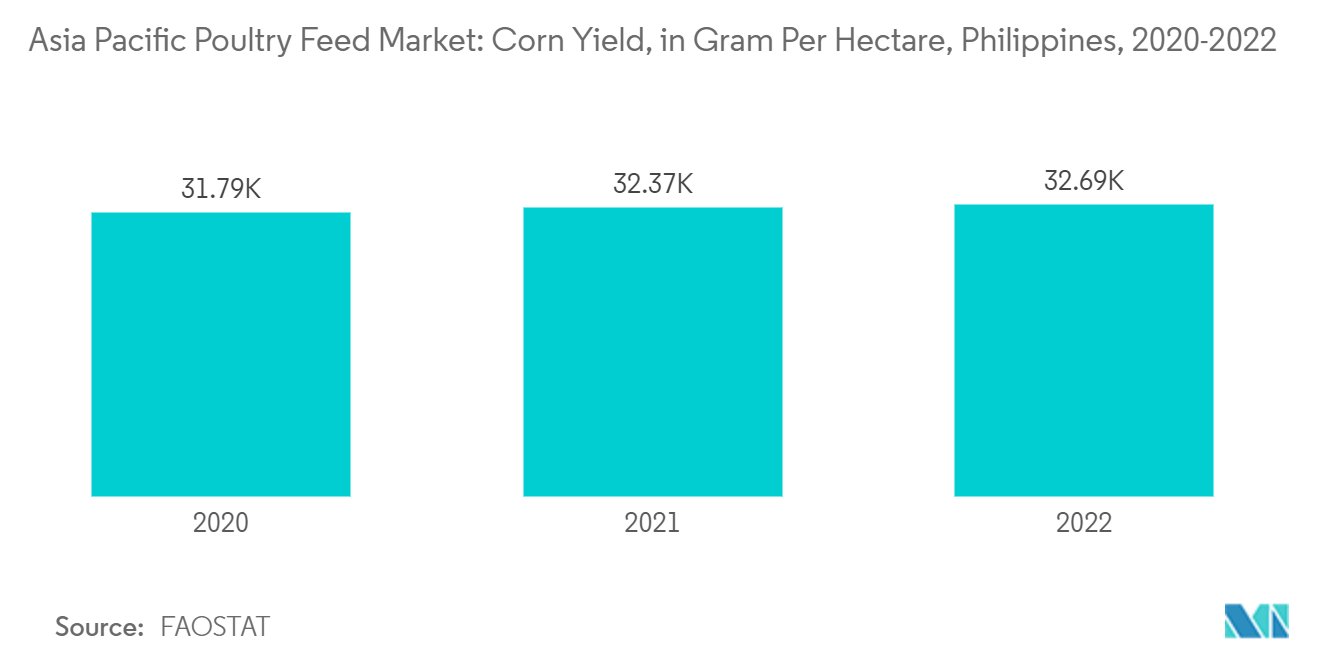
Broiler is the Largest Growing Animal Type
Chicken is the most affordable and available meat in Asian countries. The adoption of advancements in poultry genetics and breeding has resulted in faster-growing broiler breeds with higher feed conversion efficiency. These high-performing broilers require specialized compound feeds tailored to their nutritional needs, driving demand for broiler compound feed products.
According to the Food and Agriculture Organization, in 2021, Bangladesh, China, India, Indonesia, Iran, and Japan were some of the major broiler-producing countries in the region. The broiler industry in China has experienced vigorous growth over the past two decades, both in terms of broiler numbers and the level of output per bird. The demand for broiler feed continues to be high in emerging economies in Asia-Pacific. Countries like China and India have an increasing preference for broiler meat. This leads to the rising use of quality feed for the expanding poultry population.
According to the USDA, in 2023, chicken production was expected to remain steady at 14.3 million metric tons (MMT) in China. Demand for affordable chicken products, particularly white broiler meat, is projected to grow due to consumers’ shift toward a more diverse protein diet for white broiler products. Corn, soybean meal, wheat, and premixes are the major raw materials included in the production of compound feed for broilers in China. The high cost of raw materials has impacted production in recent times. Despite this, China remains a dominant player in the market.
In countries such as India, the government has implemented various policies and schemes to promote the growth of the broiler industry, such as the Integrated Poultry Development in 2020. These initiatives support feed production and encourage the establishment of feed mills, which directly contribute to the growth of compound feed for broilers.
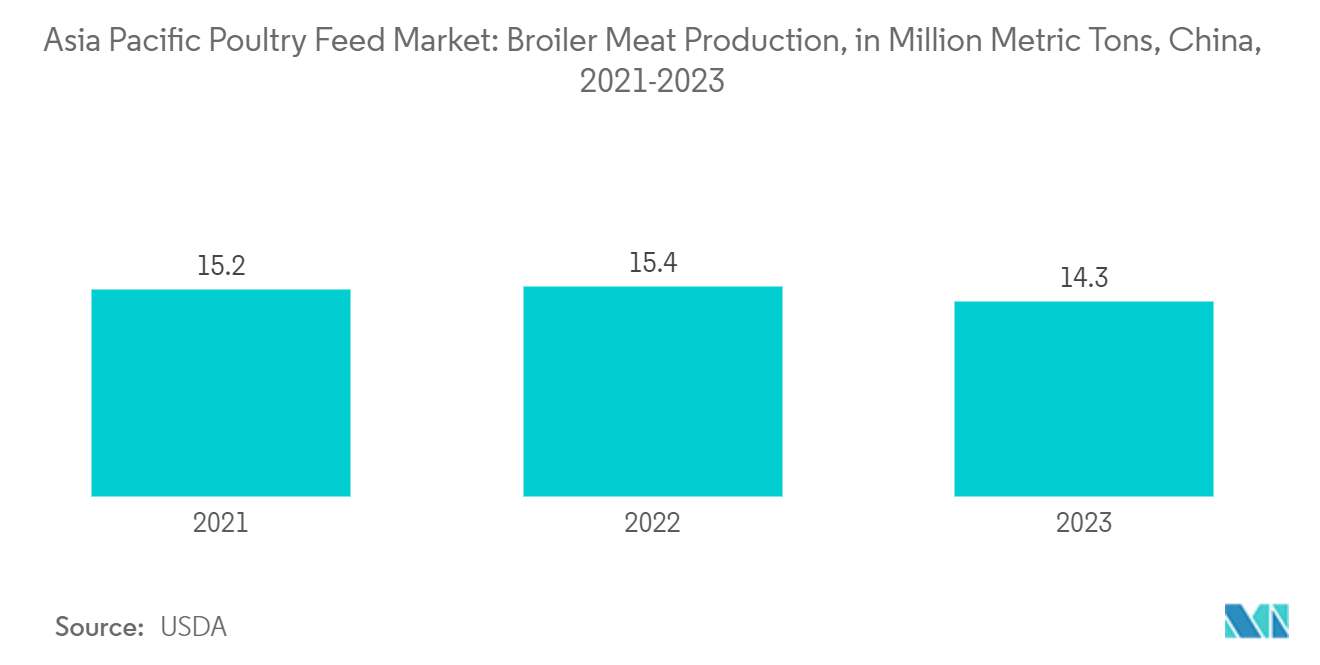
Asia Pacific Poultry Feed Industry Overview
The Asia-Pacific poultry feed market is fairly fragmented, with the presence of various participants across several countries. The market studied displays unique characteristics, such as very few large manufacturing companies on the one hand and a highly unorganized market with several regional players with small market shares on the other hand. The leading companies are focused on acquiring feed mills and small manufacturing facilities for the expansion of their businesses in both domestic and international markets.
Asia Pacific Poultry Feed Market Leaders
-
Cargill Inc.
-
AllTech
-
ADM Animal Nutrition
-
Nutreco NV
-
BASF SE
*Disclaimer: Major Players sorted in no particular order
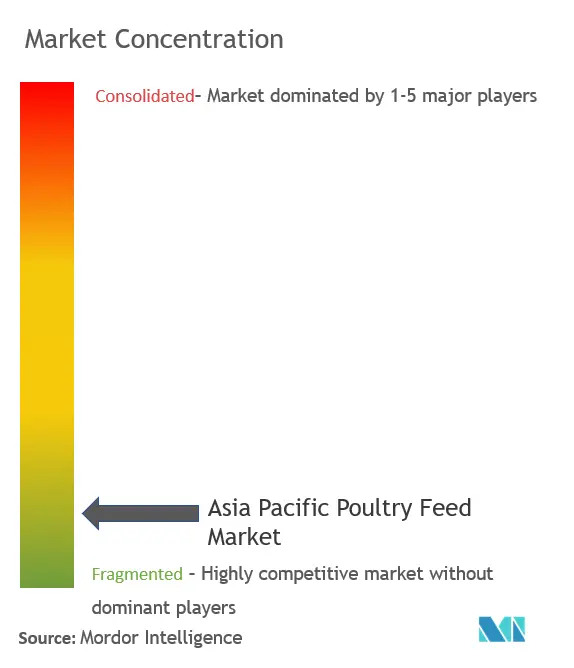
Asia Pacific Poultry Feed Market News
- April 2024: Alltech launched Allzyme Spectrum to the company’s line-up of multi-enzyme technologies. It is designed to optimize nutrient utilization in poultry by breaking down key substrates found in the diet, including NSPs and phytic acid. In addition, Allzyme Spectrum has increased egg weight, resulting in improved case weight while decreasing feed cost.
- April 2023: Cargill opened its animal nutrition factory in Nanping, Fujian. The Nanping factory is a collaboration between Cargill Animal Nutrition and local firm Fujian Nanxing Animal Health Products Co. Ltd. The facility includes a building area of 36,000 sq. m. With an annual output capacity of 300,000 tons, it is Cargill’s most expansive feed factory in China.
- February 2023: BASF collaborated with Cargill to introduce new enzyme-based products to the market, creating unique benefits for customers in the animal feed industry, including poultry. The partnership will leverage BASF's expertise in enzyme research and development, along with Cargill's experience in application and extensive market reach, to establish a shared innovation process for animal protein producers.
APAC Poultry Feed Market Report - Table of Contents
1. INTRODUCTION
- 1.1 Study Assumptions and Market Definition
- 1.2 Scope of the Study
2. RESEARCH METHODOLOGY
3. EXECUTIVE SUMMARY
4. MARKET DYNAMICS
- 4.1 Market Overview
-
4.2 Market Drivers
- 4.2.1 Rising Demand for Poultry Products
- 4.2.2 Increasing Poultry Production
- 4.2.3 Growing Demand for Animal Protein
-
4.3 Market Restraints
- 4.3.1 Rising Cost of Feed Raw Materials
- 4.3.2 Challenging Regulatory Conditions
-
4.4 Porters Five Force Analysis
- 4.4.1 Threat of New Entrants
- 4.4.2 Bargaining Power of Buyers/Consumers
- 4.4.3 Bargaining Power of Suppliers
- 4.4.4 Threat of Substitute Products
- 4.4.5 Intensity of Competitive Rivalry
5. MARKET SEGMENTATION
-
5.1 Animal Type
- 5.1.1 Layer
- 5.1.2 Broiler
- 5.1.3 Turkey
- 5.1.4 Other Animal Types
-
5.2 Ingredient
- 5.2.1 Cereal
- 5.2.2 Oilseed Meal
- 5.2.3 Molasses
- 5.2.4 Fish Oil and Fish Meal
- 5.2.5 Supplements
- 5.2.6 Other Ingredients
-
5.3 Supplements
- 5.3.1 Vitamins
- 5.3.2 Amino Acids
- 5.3.3 Antibiotics
- 5.3.4 Enzymes
- 5.3.5 Antioxidants
- 5.3.6 Acidifiers
- 5.3.7 Prebiotics
- 5.3.8 Probiotics
- 5.3.9 Other Supplements
-
5.4 Geography
- 5.4.1 Asia-Pacific
- 5.4.1.1 India
- 5.4.1.2 China
- 5.4.1.3 Japan
- 5.4.1.4 Australia
- 5.4.1.5 Pakistan
- 5.4.1.6 Rest of Asia-Pacific
6. COMPETITIVE LANDSCAPE
- 6.1 Most Adopted Strategies
- 6.2 Market Share Analysis
-
6.3 Company Profiles
- 6.3.1 Cargill Inc.
- 6.3.2 Alltech Inc.
- 6.3.3 Archer Daniels Midland
- 6.3.4 Kent Feeds
- 6.3.5 Nutreco NV
- 6.3.6 BASF SE
- 6.3.7 Kyodo Shiryo Company
- *List Not Exhaustive
7. MARKET OPPORTUNITIES AND FUTURE TRENDS
** Subject To AvailablityAsia Pacific Poultry Feed Industry Segmentation
Poultry feed is a mixture of raw materials and supplements fed to the poultry birds, sourced from either plant, animal, organic or inorganic substances or industrial processing, whether containing additives. A balanced diet is essential according to the requirements for maintenance and various productive functions. Poultry feed is carefully formulated, ensuring optimal quantities of all essential ingredients. The Asia-Pacific poultry feed market is segmented by animal type (layer, broiler, turkey, and other animal types), ingredients (cereal, oilseed meal, oil, molasses, and other ingredients), supplements (vitamins, amino acids, antibiotics, enzymes, antioxidants, acidifiers, probiotics, and prebiotics, and other supplements), and geography (India, China, Japan, Australia, Pakistan, and Rest of Asia-Pacific). The report offers the market size and forecasts in terms of value (USD) and volume (metric tons) for the segments mentioned above.
| Animal Type | Layer | |
| Broiler | ||
| Turkey | ||
| Other Animal Types | ||
| Ingredient | Cereal | |
| Oilseed Meal | ||
| Molasses | ||
| Fish Oil and Fish Meal | ||
| Supplements | ||
| Other Ingredients | ||
| Supplements | Vitamins | |
| Amino Acids | ||
| Antibiotics | ||
| Enzymes | ||
| Antioxidants | ||
| Acidifiers | ||
| Prebiotics | ||
| Probiotics | ||
| Other Supplements | ||
| Geography | Asia-Pacific | India |
| China | ||
| Japan | ||
| Australia | ||
| Pakistan | ||
| Rest of Asia-Pacific |
APAC Poultry Feed Market Research FAQs
How big is the Asia Pacific Poultry Feed Market?
The Asia Pacific Poultry Feed Market size is expected to reach USD 71.68 billion in 2024 and grow at a CAGR of 3.20% to reach USD 83.91 billion by 2029.
What is the current Asia Pacific Poultry Feed Market size?
In 2024, the Asia Pacific Poultry Feed Market size is expected to reach USD 71.68 billion.
Who are the key players in Asia Pacific Poultry Feed Market?
Cargill Inc., AllTech, ADM Animal Nutrition, Nutreco NV and BASF SE are the major companies operating in the Asia Pacific Poultry Feed Market.
What years does this Asia Pacific Poultry Feed Market cover, and what was the market size in 2023?
In 2023, the Asia Pacific Poultry Feed Market size was estimated at USD 69.39 billion. The report covers the Asia Pacific Poultry Feed Market historical market size for years: 2019, 2020, 2021, 2022 and 2023. The report also forecasts the Asia Pacific Poultry Feed Market size for years: 2024, 2025, 2026, 2027, 2028 and 2029.
APAC Poultry Feed Industry Report
Statistics for the 2024 APAC Poultry Feed market share, size and revenue growth rate, created by Mordor Intelligence™ Industry Reports. APAC Poultry Feed analysis includes a market forecast outlook 2029 and historical overview. Get a sample of this industry analysis as a free report PDF download.



